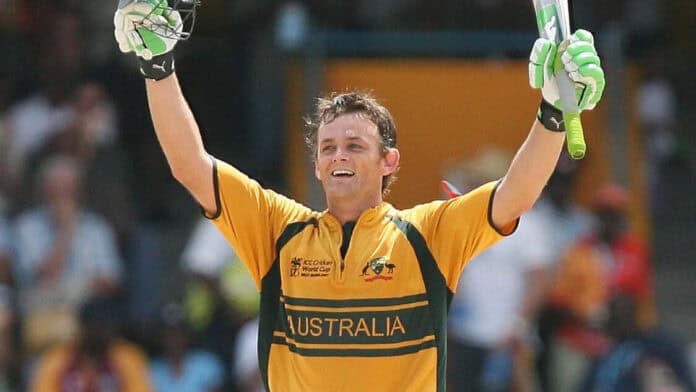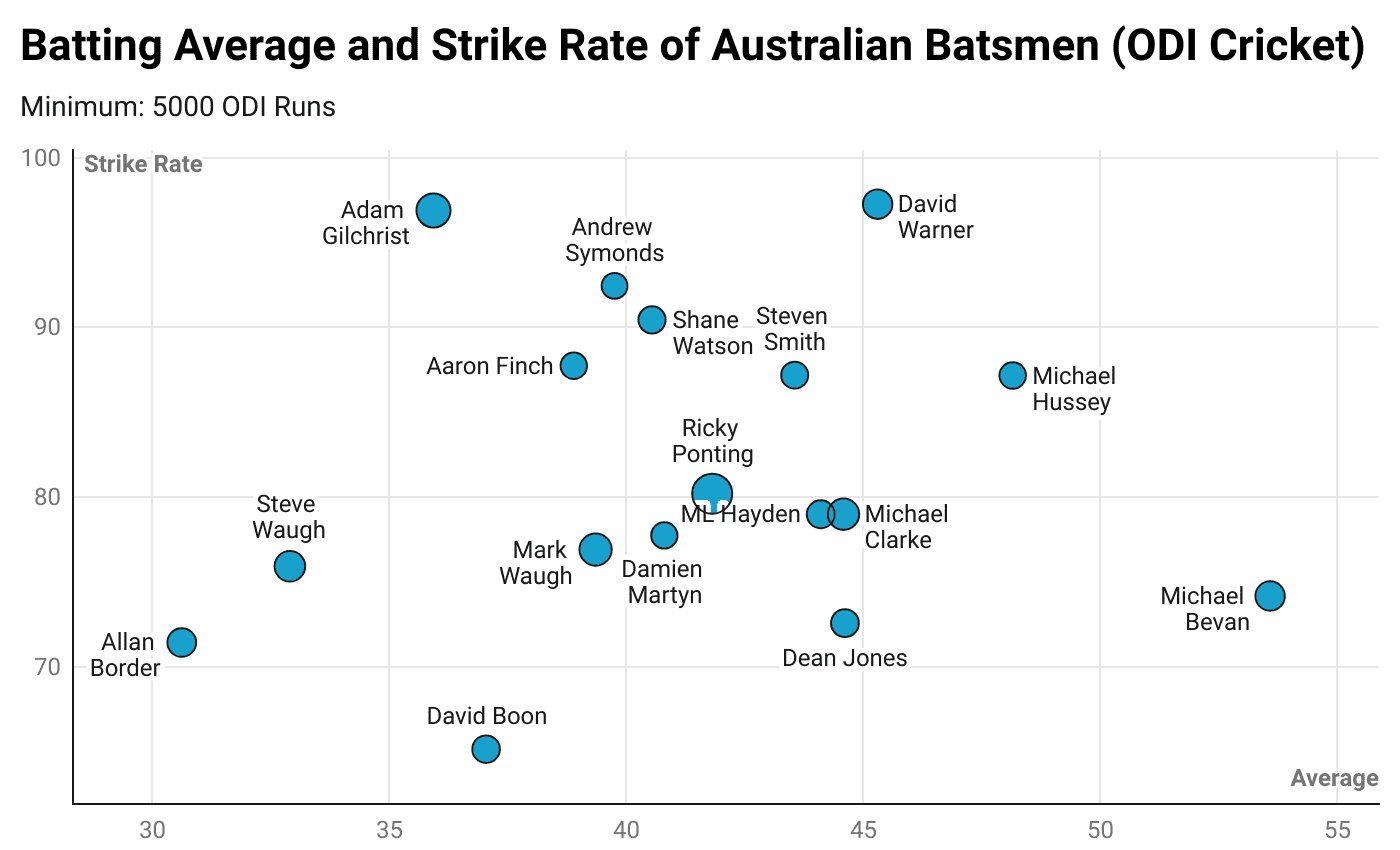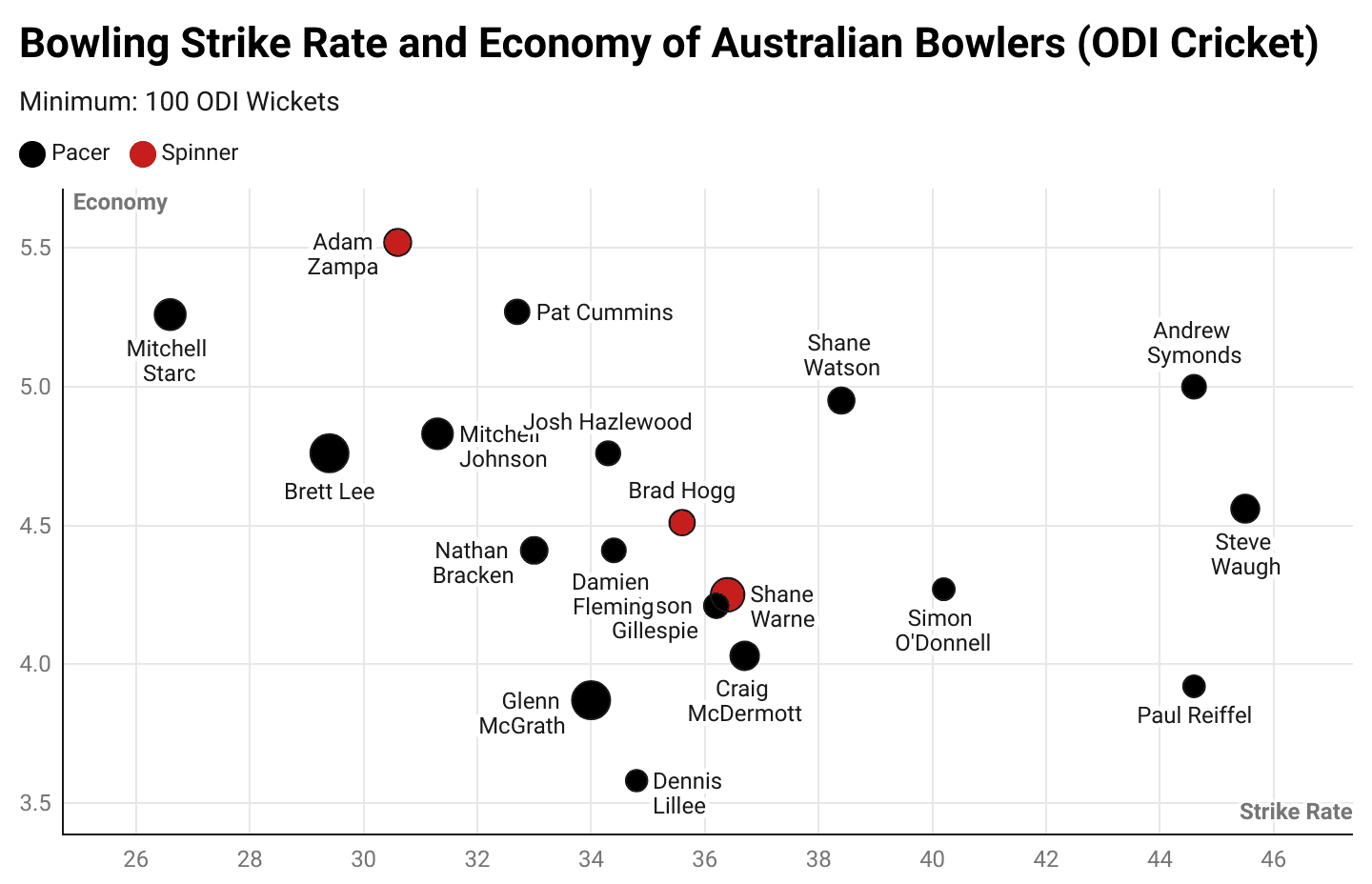A nation whose stereotypical image is that of one obsessed with sports, it seems when it comes to cricket, it is more appropriate to term Australia as a country obsessed with winning. Be it the men, women or the youth teams, Australia has carried an air of excellence that can be dated as far back as “The Invincibles” of 1948.
However, when it came to the ODIs, the baggy greens had to take a backseat to the Windies’ domination in their initial years. It becomes ironic against the backdrop of consistent Aussie dominance that Australia’s first of 6 World Cup trophies came in a tournament where they were ranked outsiders in 1987. Things remained quiet for the subsequent years, but come the turn of the century and Australia’s reign of dominance was established through their 2nd World Cup victory in 99′. A reign which saw 2 World Cups and 2 champions trophies being adjusted into the Australian trophy cabinet. And despite the comforts of the tag of favourites, the Aussies have never lost their alternative ability of fighting against the odds evident in their 6th World Cup triumph in 2023.
Hereby, we present Australia’s All-time ODI XI to you, celebrating cricket’s villains yet, more importantly, the ultimate winners.
Adam Gilchrist (WK)
Picking up the mantle of chaotic left-handed openers from Sanath and Saeed, Gilchrist added a touch of reliability to his destructive style throughout the early 00s.
- Matches: 287
- Runs: 9,619
- Average: 35.89
- Strike Rate: 96.94
- Dismissals: 472
From 1998-2008, Gilly’s strike rate never went below 88 and the lowest his average stooped down was 31 (filtered by year). So, although he never had an iconic calendar year such as Jayasuriya 97 or Anwar 96, Adam’s uniformity both behind and in front of the stumps meant he was a part of the winning podium for all 3 of his World Cups.
His overall World Cup numbers resemble his career statistics; however, when it comes to exclusively knockouts, Churchy’s 3 fifties in consecutive finals are a part of cricketing folklore. Additionally, his strike rate of 109.87 across all ICC knockout games stands as the 3rd highest figure (min. 150 runs).
And to combine with his slog sweeps, was his nimble glovework. Gilchrist’s dismissal/innings ratio of 1.65 is the best for any wicketkeeper in ODI history.
David Warner
The most stacked position of this XI, with the other takers being Mark Waugh and Matthew Hayden, “the Bull” was our choice for the 2nd opener spot, given he edged them by a small yet definite margin in the Z-Factor metric, which you can check out in our article about ODI Openers.
- Matches: 161
- Runs: 6,932
- Average: 45.3
- Strike Rate: 97.26
Recently announcing his retirement following his 2nd World Champions medal, Warner is an integral component in each of those wins, finishing his career with the 6th most runs in the tournament’s history. He has been able to infuse a method of consistency within his rugged jabs, evident in the fact that only Tendulkar has a better average and a better strike rate amongst openers with min. 5k runs in the article mentioned above.
A batter with a penchant for bigger scores; this is evident in his conversion rate of 40.00 (6th highest) and 7 150+ scores (2nd most). A man who isn’t shy of controversies but whose temper has been watered down over time, Warner’s 5-year stretch from 2015-19 is when he was at the peak of his powers, scoring 3,451 runs @57.52 with a scoring rate of 102.13.
Ricky Ponting (C)
The 4th highest run-getter of the format, Ricky was the quintessential middle-order anchor of his time, personifying the attitude that became synonymous with the Australian side of the 2000s.
- Matches: 375
- Runs: 13,704
- Average: 42.03
- Strike Rate: 80.39
An 18-year career that saw him transform from the French beard to the now world-famous clean-shaved look, Ponting’s away average of 45.04 is the 15th best in ODIs (no neutral games and min. 1000 runs), which also triumphs over his home average of 39.17. Having the 4th most centuries, he had a hundred against each of the test-playing nations he faced and his gross performance against them was up to the mark too, with his lowest average recorded against them being 35.9 vs the Windies.
Accumulating 1,743 runs (3rd most) across 5 editions, Ponting finished as a winner in 3 of them. 2 of the later ones were where he led the nation as a captain. Despite all of the batting accolades that we listed, the fact that Ponting’s legacy as a captain at times overshadows his legacy as a batter is a testament to his achievements as a leader. 2 World Cups and 2 Champions trophies, Ricky’s win% of 71.74 is the 2nd best in ODIs (min. 50 matches).
Dean Jones
One of the few batsmen to have “quick runs stolen” included in their highlight reels, Jones wasn’t only one of the best white-ball batters of the 80s but also someone who revolutionised the art to an extent.
- Matches: 164
- Runs: 6,068
- Average: 44.62
- Strike Rate: 72.57
Be it being fidgety around the crease or running like a lunatic across the pitch, Deano’s out-of-the-box perspectives seemed to have been forgotten as the pages have turned in the cricketing world over the years.
For the first 100 games of his career, he averaged over 50, the best in the world. And he wasn’t too far behind in the striking department, with only a handful (5) having a better scoring rate. However, him averaging 35 for the last 4 years meant his overall statistics took a hit.
The fact that no other Aussie batter averaged above 40 in the games Dean was part of, and the strike rates of the rest of his top order partners (65 and 55), show how important he was at a time when Australia were finding their footing in this format.
Andrew Symonds
Amongst the best athletes the sport has ever seen, Symonds’s unadulterated range hitting combined with his strategic off-spin/medium-paced wobblers are more than enough to secure a spot in the XI.
- Matches: 198
- Runs: 5088
- Average: 39.75 (44.52 at no. 5)
- Strike Rate: 92.44
- Wickets: 133
- Bowl Average: 37.2
Symond’s first 5 years didn’t do justice to his talent, with him averaging around 26 in this period. Given how competitive the national side was at the time, it’s highly impressive how the management persisted with him, and he repaid this faith in the 03 winning campaign, a tournament in which he started off with a 143(125)* against Pakistan when he entered at 86/4.
In fact, his average of 76.66 across 26 ICC games is the 3rd best for any batter who scored 100 runs or more. And this went up to 103 when it came exclusively to the World Cup matches. With only Ryan ten Doeschate simultaneously possessing a better average as well as a better strike during the 12-year period Symonds played in, another anomalous feature of Andrew’s career was his contrasting numbers in and out of Australia. Symonds scored 29 runs per dismissal at home, whereas this statistic shot up to nearly 50 in 115 games held outside of the country.
Michael Bevan
The ability to snatch victory from the jaws of death is something one can’t fully justify with statistics, yet it remains Bevan’s most celebrated ability.
- Matches: 232
- Runs: 6,912
- Average: 53.58
- Strike Rate: 74.16
Although Bevan had an average of nearly 60 at number 4, we couldn’t displace him from his perch at lower down the order. One of the first players to be established as a synonym for the term “finisher”. Averaging 56.72 at 6, no one else even averaged 50 (min. 30 innings) and moreover, his strike rate also saw a marginal increase over here.
Known for his iconic partnerships with lesser-talented batters, the lowest Bevan’s average went against any non-associate side was 44.73 against South Africa. Having batted at all positions from number 4-7, he had a 40+ average in each of them. To add to his acumen of versatility, he also averaged above 50 in games outside of Australia. Although one might say his mean was inflated through his 67 career not-outs, Bevan had an RPI of 35.26. For context, Ponting’s RPI stood at 37.54.
Shane Watson
Amongst the last breed of all-rounders who were able to sustain a career as long as 14 years while being a key contributor in both departments, Shane’s primary position was that of an opener, but due to team dynamics and a lack of a proper 5th bowler alternative, Watson will occupy position 7.
- Matches: 190
- Runs: 5,757
- Average: 40.54
- Strike Rate: 90.44
- Wickets: 168
- Average: 31.79
- Economy: 4.95
To start off, Watson has 40 games at no. 6 or below, where he scored his runs at an average of 34 with a scoring rate of 90.55. Not bad right? Apart from this, it’s a shame how Watson’s batting mastery overshadowed his handy spells with the ball in the middle overs.
An away average of 30.81, although Watson didn’t achieve much with the ball in the World Cup, he was a key part of 2 champions trophy-winning squads, picking up 17 wickets @23.29. And to present how valuable an all-rounder he was, his average difference of 8.74 is the 4th best in ODIs (min. 1.5K runs and 75 wickets) and has gone under 0 against only 2 of his 15 opponents.
Shane Warne
Cricketing trivia, such as Tendulkar having more fifers than Warne or Jayasuriya having more ODI wickets than Shane, have diminished the white-ball legacy of one of the sport’s enigmatic characters, but in our opinion, he has done enough to be a part of the all-time ODI side of the greatest cricketing nation.
- Matches: 194
- Wickets: 293
- Average: 25.73
- Strike Rate: 36.3
- Economy: 4.25
Storming into the format with picking his first 100 wickets @20.47, the injuries from 97′ onwards took a toll on him, with his average in the period 1997-retirement rising up to 28.9. However, his most prolific year came during this slump when Warne picked up 62 wickets in the year 1999, including the 99′ World Cup winning campaign where he was the joint-highest wicket-taker of the tournament.
Part of only 2 World Cups, he was tremendous in both of them, picking up 32 wickets @19.5. He surprisingly struggled in Asia, with an average of 29.44 over there being the worst of his across the 5 continents.
Mitchell Starc
Keeping the thrill of fast-bowling alive amongst the younger audience in an era where such individuals are few and far between due to the white-ball game bending itself towards the batters, Mitchell Starc’s inswinging yorkers have etched themselves amongst the iconic images of his craft.
- Matches: 121
- Wickets: 236
- Average: 22.96
- Strike Rate: 26.4
- Economy: 5.21
Talking about striking the timber, Starc’s 37.29% of career wickets coming as bowled dismissals is the highest in ODIs (min 150 wickets). Following Lee’s precedence regarding wicket-taking prowess, his career strike rate of 26.4 is the 2nd best under the same criteria.
The reason that pushes him down when it comes to the ATG status conversations is his ordinary performance against the top 3 opponents of his time, India, South Africa and England; averaging above 30 against each of them. However, the fact that he has been amongst the top bowlers of his era, with only 2 other players (non-associate) possessing a better average since his debut, combined with his unworldly World Cup campaigns, is enough for us to deem him as one of the greats of the format.
Highest wicket-taker of the 15′ and 19′ campaigns, Mitchell Starc, is the 3rd ever highest wicket-getter in CWCs, despite playing in what were by far the 3 most batting-friendly editions.
Brett Lee
The exact opposite of our no. 11 when it came to the importance of pace in their respective arsenal, this was also perhaps why both Lee and McGrath formed one of the most prolific yet effective bowling pairs of the format.
- Matches: 221
- Wickets: 380
- Average: 23.36
- Strike Rate: 29.4
- Economy: 4.76
Though the latter overshadows the former when it comes to stature and legacy, Lee was superior when it came to wicket-taking abilities. His bowling strike rate of 29.4 is the 3rd best for anyone who debuted prior to the 2010s (min. 100 wickets). Moreover, only Shami and our previous bowler have picked more World Cup wickets at a better strike rate than Lee’s 23.57.
Despite minimal variations, Lee’s record in Asia supersedes even his own record in Australia. Only 5 other bowlers have a better bowling average in the subcontinent than Brett’s 22.72. As is the case with the rest of his bowling partners for today, Brett improved his statistics at the premier tournament, with only Shami picking more wickets at a better norm than Binga’s 17.87.
Glenn McGrath
A bowler whose name has become synonymous with the term “metronome” over the years, Glenn McGrath has also come to be associated with the tag of the “greatest ODI bowler”.
- Matches: 249
- Wickets: 380
- Average: 21.98
- Strike Rate: 34.0
- Economy: 3.88
Glenn didn’t have express velocity nor did he possess a magical ability such as Akram’s reverse swing or Ambrose’s yorkers, yet his resume is as brilliant as anyone in both formats.
The highest his bowling average went against any opponent was 26.76 against India, and the highest in any country was 28.66 in India. In fact, in our article about era-adjusted numbers, Glenn McGrath was the one with the best era-adjusted average amongst bowlers with 300 or more career wickets despite having company from individuals such as Wasim, Waqar, and Muralitharan.
Lastly, no discourse is complete about the greatest bowlers without mentioning how they fared in the bigger matches, and McGrath ticked this box like the others. Highest wicket-taker in World Cups and 5th highest in Champions trophy with an average of 18.19 and 19.61 respectively, McGrath also picked up 70 wickets across knockouts of all multi-nation tournaments @18.25.
To summarise, perfection rather than consistency seems the better synonym for McGrath.
Alternatives
Given the sheer quality and quantity Australia has produced over the years, a second all-time Australia XI would give other nations’ first-string sides a run for their money.
As mentioned above, openers Mark Waugh and Hayden missed out since we felt Warner tipped them over in almost every category, whereas a strong case is made for Hussey and Maxwell. As great as both of these batters are, they couldn’t replace the “Pyjama Picasso” for us. Watson had to be picked owing to his superior skills as the 5th bowler of the side, whereas a case could have been made for replacing Symonds, more so for Maxwell, given the former’s lacklustre ICC record. In the end, it’s splitting hairs, and we felt Symonds had the more rounded resume.
The pace quadrant of Lillee, Mcdermott, Bracken and Johnson was a terrific mix, but it was improbable to dislodge any of our 3 pacers, whereas Chinaman Hogg had an outside shot at Warne’s position.
Australia All Time ODI XI is
- Adam Gilchrist (WK)
- David Warner
- Ricky Ponting (C)
- Dean Jones
- Andrew Symonds
- Michael Bevan
- Shane Watson
- Shane Warne
- Mitchell Starc
- Brett Lee
- Glenn McGrath
12th Man: Glenn Maxwell
Extras: Nathan Bracken, Brad Hogg, Matthew Hayden



